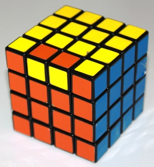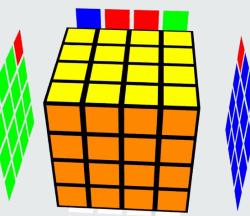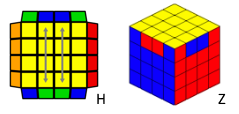Parity on the 4x4 Rubik’s Cube
Parity is something that most puzzle solvers despise. Extra algorithms that you have to learn in order to solve the cube 100% of the time. It is something that can slow speedsolvers down immensely in official solves, and is generally seen as a pain to deal with. Today I’m going to take a look at parity in all its forms and see why it happens and the reasons why it’s impossible to prevent completely.
Where Parity Occurs and how to solve it.
| a | a | ||
| b | b | ||
One type of pseudo-parity is edge parity. For even layered cubes, this isn’t technically a parity at all, but it still requires an extra “algorithm” to solve, even though it is very short and just involves using the same moves you do to solve the rest of the edges, but in a different order.
It happens when all but two edges are solved. These two edges look the same, but inverted. In the picture, the blue-red edge on the left needs to be paired with the red-blue edge on the right, and the same for the blue-orange edges.
If you know how to solve a 4x4, you will know the flipping algorithm. This is used to flip an edge during edge solving (this algorithm can’t be used for OLL parity because it affects other parts of the cube that aren’t necessary to preserve during edge pairing such as corner orientation and the positions of the edges on top. The flipping algorithm is as follows – R U R’ F R’ F’ R. If you do this to a solved cube, you can see how the algorithm affects the rest of the puzzle, but this is not noticeable during edge pairing.
Now solving this parity should be simple. If you think about what the algorithm is doing, it’s actually quite simple – Uw’ R U R’ F R’ F’ R Uw.
All this algorithm does is slice along so that the other red-blue piece is above the orange-blue piece, flips the edge, then slices back, solving both edges.
The main types of Parity are OLL and PLL Parity for NxN twisty puzzles. It is important to note that these parities can ONLY occur on even layered cubes (4x4, 6x6 etc.) and never on odd layered cubes (3x3, 5x5 etc.). This will be explained later.
OLL Parity
 OLL Parity is a speedsolver’s worst nightmare. PLL Parity can also be a pain, but nothing in comparison to OLL parity. This image shows OLL parity in its purest form, but any state where there is an odd number of yellow edges facing upwards is the same. This is the indication that you have parity. It is called so because it is first noticed during the OLL stage of a solve.
OLL Parity is a speedsolver’s worst nightmare. PLL Parity can also be a pain, but nothing in comparison to OLL parity. This image shows OLL parity in its purest form, but any state where there is an odd number of yellow edges facing upwards is the same. This is the indication that you have parity. It is called so because it is first noticed during the OLL stage of a solve.
It is caused when solving the edges. You see, on a 3x3 puzzle each of the edges are basically “made” for you. They can’t be split in two, therefore they can’t be “flipped”. However, when solving edges on a 4x4, you have no way of knowing whether an edge is “solved” or “flipped”. This means when you have reduced the cube to a 3x3 with the reduction method, although it may just look like a scrambled 3x3, picture it as a scrambled 3x3 after one edge has been removed and put back in the wrong way around.
Because there is no way of telling which way round an edge should go, it’s really a 50-50 chance as to whether or not the number of “flipped” edges you will end up with after edge solving is odd or even. An even number of flipped edges means there is no OLL parity. If you want to see for yourself, take out two edges from a 3x3 and put them back in their places but flipped. Now scramble the cube, and you’ll find that you can solve it. An odd number of flipped edges means that there is OLL parity. Do the same thing: take a 3x3 cube and this time flip three edges in their places. No matter what you do, there will always be one flipped edge remaining when you try to solve it.
This is combined with the fact that you have to solve the centres, meaning they can all be in different places. When solving the first two centres, you can solve them on any side, as long as they are opposite one another. Therefore there is absolutely no way of telling whether an edge is solved correctly or not, meaning OLL parity is completely random.
There are many algorithms that are all unique apart from one thing – They are all very long and difficult to memorise. Many speedcubers try a few different algorithms before they find one they’re able to solve decently fast. However, many speedcubers also use muscle memory for most of the algorithm memorisation, meaning they won’t be able to perform the same algorithm slowly without making a mistake. Even with the best memory and the best algorithm, most speedcubers will struggle to solve OLL parity in under 3-4 seconds, meaning that it can be the cause of a ruined average. OLL parity is also known for the large risk of pieces popping from the puzzle during execution. Because it involves almost exclusively slice turns (turns that would be impossible on a 3x3) and is executed as fast as possible, a pop during this stage can be much larger than a normal pop, and combined with the strong reliance on muscle memory that most speedcubers have, this can prevent the solver from completing the rest of the algorithm without error when the cube is put back together.
PLL Parity
PLL Parity is like the final nail in the coffin for a speedcuber who has already had to deal with OLL parity. Although it is much easier to execute and the algorithms are easier to remember, the time it takes to execute combined with the time of OLL parity can add 6-7 seconds total to an average speedcuber’s solve time.
These images show PLL parity in their pure forms. However, most speedcubers solve PLL parity as soon as they recognise it, which is when OLL has been completed and any OLL parity has been dealt with. The best way to spot PLL parity is when you see a PLL case that is impossible to get on a 3x3 cube. One of the best examples for this is the pseudo-T permutation. After finishing OLL, you will notice the two bars that indicate a T permutation. But instead of having headlights on the side that the bars point towards, you will have a solved bar.

The main algorithm people learn for PLL parity swaps the two edges shown in the first picture. This is called the Half-H perm case. The other case is the Half-Z perm case, and the same algorithm is used but with a setup beforehand. The setup moves the edge on the right so that it is opposite the edge on the front, by doing R2 D’ and then rotating so that the F face is now the U face, then performing the same algorithm.

It occurs for a similar reason to OLL parity. During edge pairing it is impossible to tell whether edges are swapped, therefore having two swapped edges results in some form of PLL parity.
These parities can happen on any even NxN layered cube. For a 4x4 there are two edges that need pairing, but with a 6x6 there are 4. Parities occur, but they are exactly the same as 4x4 parity, they just look bigger.
I won’t provide specific algorithms for OLL and PLL parity here because there are so many that are widely used. If you want to find a list of these, check out this page for a full list of all 4x4 Parity algorithms.